Research on Strata Deformation Induced by EPB Tunneling in Round Gravel Stratum and Its Control Technology
Abstract
:1. Introduction
2. Field Test Plan
2.1. Project Overview
2.2. Geological and Hydrological Conditions
2.3. Field Monitoring Content and Layout
3. Measured Analysis of Stratum Deformation
3.1. Surface Settlement Analysis
3.2. Analysis of Vertical Displacement of Stratum
3.3. Analysis of Horizontal Displacement of Stratum
4. Analysis of Shield Tunneling Parameters
4.1. Chamber Earth Pressure and Thrust Force
4.2. Torque of Cutter
4.3. Grouting Pressure and Grouting Volume
5. Discussion
5.1. Influence of Chamber Earth Pressure and Thrust Force on Surface Deformation
5.2. Influence of Torque of Cutter on Surface Deformation
5.3. Effects of Grouting Pressure and Grouting Volume on Surface Deformation
5.4. Discussion on Vertical Displacement Anomaly of Stratum in North Line
6. Conclusions
- (1)
- When the EPB shield passes through the round gravel stratum, the chamber earth pressure, thrust force, torque of the cutter, grouting pressure, and grouting volume are all positively correlated with the surface. Before the shield arrives at the section, the influence of chamber earth pressure, thrust force, and torque of the cutter on the surface deformation are mainly affected by the change in the stratum soil pressure in the tunneling stage, and the chamber earth pressure is the tunneling parameter that affects the surface deformation the most.In the stage of the shield tail passing section, the grouting volume and grouting pressure on the surface deformation are mainly affected by the change in the void ratio of the stratum, and the grouting volume is the tunneling parameter that has the greatest influence on the surface deformation.
- (2)
- During the process of the EPB shield passing through the round gravel stratum, the deformation curve of the surface corresponds to the Gauss curve, and the curve law conforms to the settlement form of the Peck formula. The heave value of the southern line reaches the maximum during the crossing stage, and the northern line reaches the maximum when it approaches the monitoring surface.
- (3)
- The stratum around the southern line was heaved before the shield arriving section, fluctuated during the crossing stage, decreased after the shield tail pass section, and finally stabilized. The closer it is to the tunnel, the greater the degree of disturbance and the greater the change in the vertical displacement of the ground surface. The stratum displacement of the north line is weak before the shield arriving section reaches the heave degree, and it is in a settlement state during the crossing stage and after the shield tail passing section. Combining the three aspects of soil layer thickness, soil compressive modulus, earth stress release, and grouting pressure offset, the problem that the settlement value at the depth of 6 m is greater than that at the depth of 8 m and 10 m is explained.
- (4)
- The horizontal displacement of the soil increases along with the depth fluctuation and the maximum value is observed at a depth of 10 m. In the tunneling stage, the minimum value occurs when the shield does not reach the monitoring section, and the maximum value is reached when the shield tail passes the section. The closer to the tunnel axis, the greater the horizontal displacement along with the depth.
Author Contributions
Funding
Institutional Review Board Statement
Informed Consent Statement
Data Availability Statement
Conflicts of Interest
References
- Wen, J.Y. EPBS Tunnel Construction in Soft Soil and Fractured Formation: A Case Study of LanZhou Subway Line 1. American Society of Civil Engineers. In Proceedings of the International Conference on Pipelines and Trenchless Technology 2014, Xiamen, China, 13–15 November 2014; pp. 780–790. [Google Scholar] [CrossRef]
- Zhu, H.H.; Xu, Q.W.; Zheng, Q.Z.; Liao, S.M. Experimental study on the working parameters of EPB shield tunneling in soft ground. China Civ. Eng. J. 2007, 9, 87–94. (In Chinese) [Google Scholar]
- Farmer, P.B.; Attewell, I.W. Ground Deformations Resulting from Shield Tunnelling in London Clay. Can. Geotech. J. 1974, 11, 380–395. [Google Scholar] [CrossRef]
- Deane, A.P. The Heathrow express trial tunnel. Int. J. Rock Mech. Min. Sci. Geomech. Abstr. 1995, 32, 411A. [Google Scholar] [CrossRef]
- Van der Berg, J.P.; Clayton, C.R.I.; Powell, D.B. Displacements ahead of an advancing NATM tunnel in the London clay. Géotechnique 2003, 53, 767–784. [Google Scholar] [CrossRef]
- Clayton, C.R.I.; Van Der Berg, J.P.; Thomas, A.H. Monitoring and displacements at Heathrow Express Terminal 4 station tunnels. Géotechnique 2006, 56, 323–334. [Google Scholar] [CrossRef]
- Standing, J.; Selemetas, D. Greenfield ground response to EPBM tunnelling in London Clay. Geotechnique 2013, 63, 989–1007. [Google Scholar] [CrossRef]
- Wan, M.S.P.; Standing, J.R.; Potts, D.M.; Burland, J.B. Measured short-term subsurface ground displacements from EPBM tunnelling in London Clay. Géotechnique 2017, 67, 748–779. [Google Scholar] [CrossRef]
- Lee, K.M.; Ji, H.W.; Shen, C.K.; Liu, J.H.; Bai, T.H. Ground response to the construction of Shanghai metro tunnel-line 2. Soils Found. 1999, 39, 113–134. [Google Scholar] [CrossRef] [Green Version]
- Xu, Q.W.; Zhu, H.H.; Ding, W.Q.; Ge, X.R. Laboratory model tests and field investigations of EPB shield machine tunnelling in soft ground in Shanghai. Tunn. Undergr. Space Technol. 2011, 26, 1–14. [Google Scholar] [CrossRef]
- Xie, X.; Yang, Y.; Ji, M. Analysis of ground surface settlement induced by the construction of a large-diameter shield-driven tunnel in Shanghai, China. Tunn. Undergr. Space Technol. Inc. Trenchless Technol. Res. 2016, 51, 120–132. [Google Scholar] [CrossRef]
- Zhu, Y.H.; Gao, F.; Ye, J.N.; Bian, X.C.; Lin, W.A.; Chen, Y.M. Lateral Ground Displacement Induced by EPB Tunneling in Ningbo Soft Clay. In Proceedings of the International Symposium on Environmental Vibration and Transportation Geodynamics, Hangzhou, China, 28–30 October 2016; Springer: Singapore, 2016. [Google Scholar] [CrossRef]
- He, C.; Feng, K.; Fang, Y.; Jiang, Y.V. Surface settlement caused by twin-parallel shield tunnelling in sandy cobble strata. J. Zhejiang Univ. SCIENCE A 2012, 13, 858–869. [Google Scholar] [CrossRef]
- Zhang, Z.X.; Zhang, H.; Yan, J.Y. A case study on the behavior of shield tunneling in sandy cobble ground. Environ. Earth Sci. 2013, 69, 1891–1900. [Google Scholar] [CrossRef]
- Liu, C.; Cui, J.; Zhang, Z.X.; Liu, H.; Huang, X.; Zhang, C.Q. The role of TBM asymmetric tail-grouting on surface settlement in coarse-grained soils of urban area: Field tests and FEA modelling. Tunn. Undergr. Space Technol. 2021, 111, 103857. [Google Scholar] [CrossRef]
- Nomoto, T.; Imamura, S.; Hagiwara, T.; Osamu, K. Shield Tunnel Construction in Centrifuge. J. Geotech. Geoenviron. Eng. 1999, 125, 289–300. [Google Scholar] [CrossRef]
- Cheng, H.Z.; Chen, J.; Chen, G.L. Analysis of ground surface settlement induced by a large EPB shield tunnelling: A case study in Beijing, China. Environ. Earth Sci. 2019, 78, 605. [Google Scholar] [CrossRef]
- Jiang, X.L.; Cui, Y.; Li, Y.; Zhao, Z.M. Measurement and simulation of ground settlements of Tianjin subway shield tunnel construction. Rock Soil Mech.-Wuhan 2005, 26, 91–95. (In Chinese) [Google Scholar]
- Yu, X.F.; Ren, H.; Hu, X.D. Analysis of the Disturbance to Surrounding Soils During Shield Driving for the Hangzhou Metro Line 1 Project. Mod. Tunn. Technol. 2014, 51, 166–173. (In Chinese) [Google Scholar]
- Yang, Y.; Tan, Z.S.; Peng, B.; Li, J.P.; Wang, G. Study on optimization boring parameters of earth pressure balance shield in water-soaked round gravel strata. China Civ. Eng. J. 2017, 50, 94–98. (In Chinese) [Google Scholar]
- Lee, G.T.K.; Ng, C.W. Effects of advancing open face tunneling on an existing loaded pile. J. Geotech. Geoenviron. Eng. 2005, 131, 193–201. [Google Scholar] [CrossRef]
- Zhang, H.; Chen, S.G.; Deng, X.F. Analysis of the effect of shield tunneling parameters on ground settlement. Mod. Tunn. Technol. 2010, 47, 48–53. (In Chinese) [Google Scholar]
- Zhou, K.; Tan, H.X.; Liang, X.Q.; Qu, C.Z.; Yang, S.J. Analysis of the effect of shield tunneling parameters on ground settlement in Changsha Metro Line 1. J. Hum. Inst. Eng. 2016, 26, 74–79. (In Chinese) [Google Scholar]
- Bezuijen, A.; Talmon, A.M.; Kaalberg, F.J.; Plugge, R. Field measurements of grout pressures during tunnelling of the Sophia Rail Tunnel. Soils Found. 2004, 44, 39–48. [Google Scholar] [CrossRef]
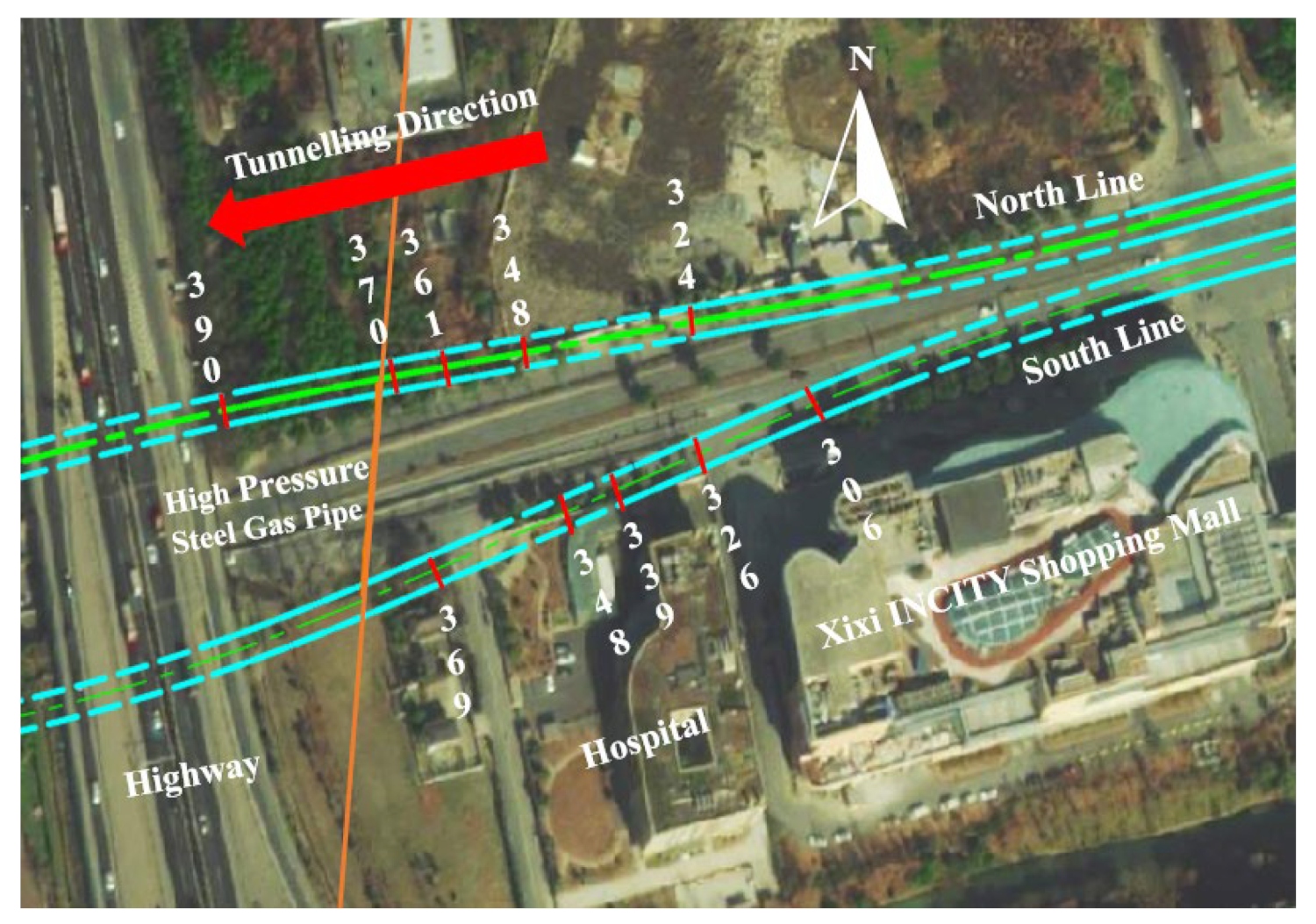

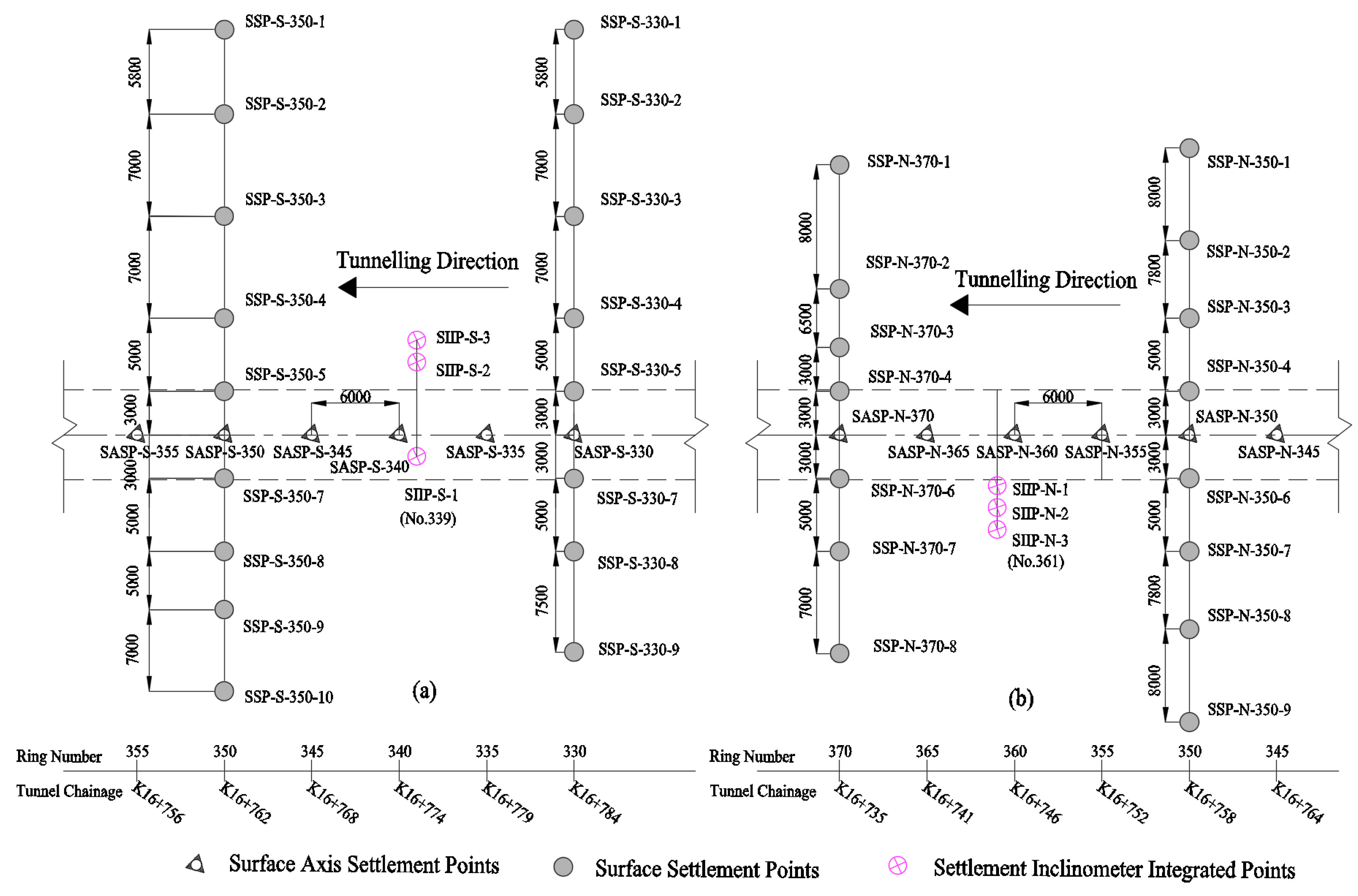


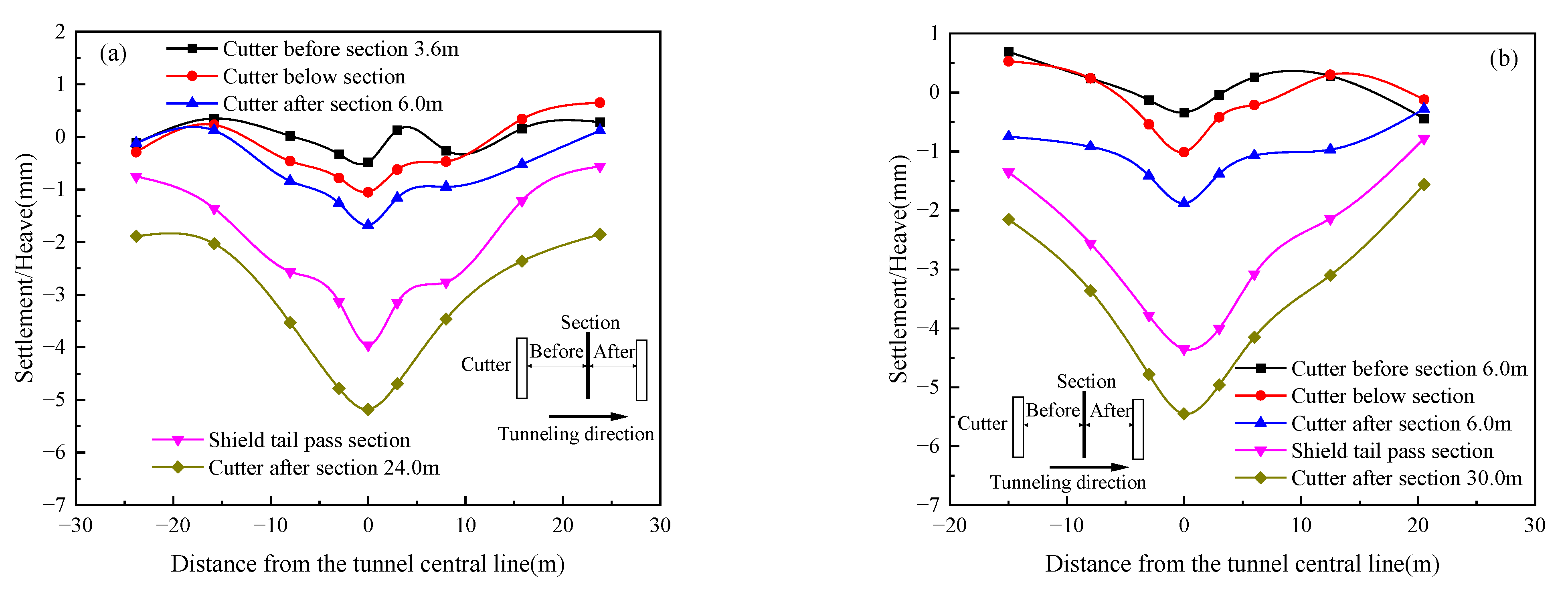


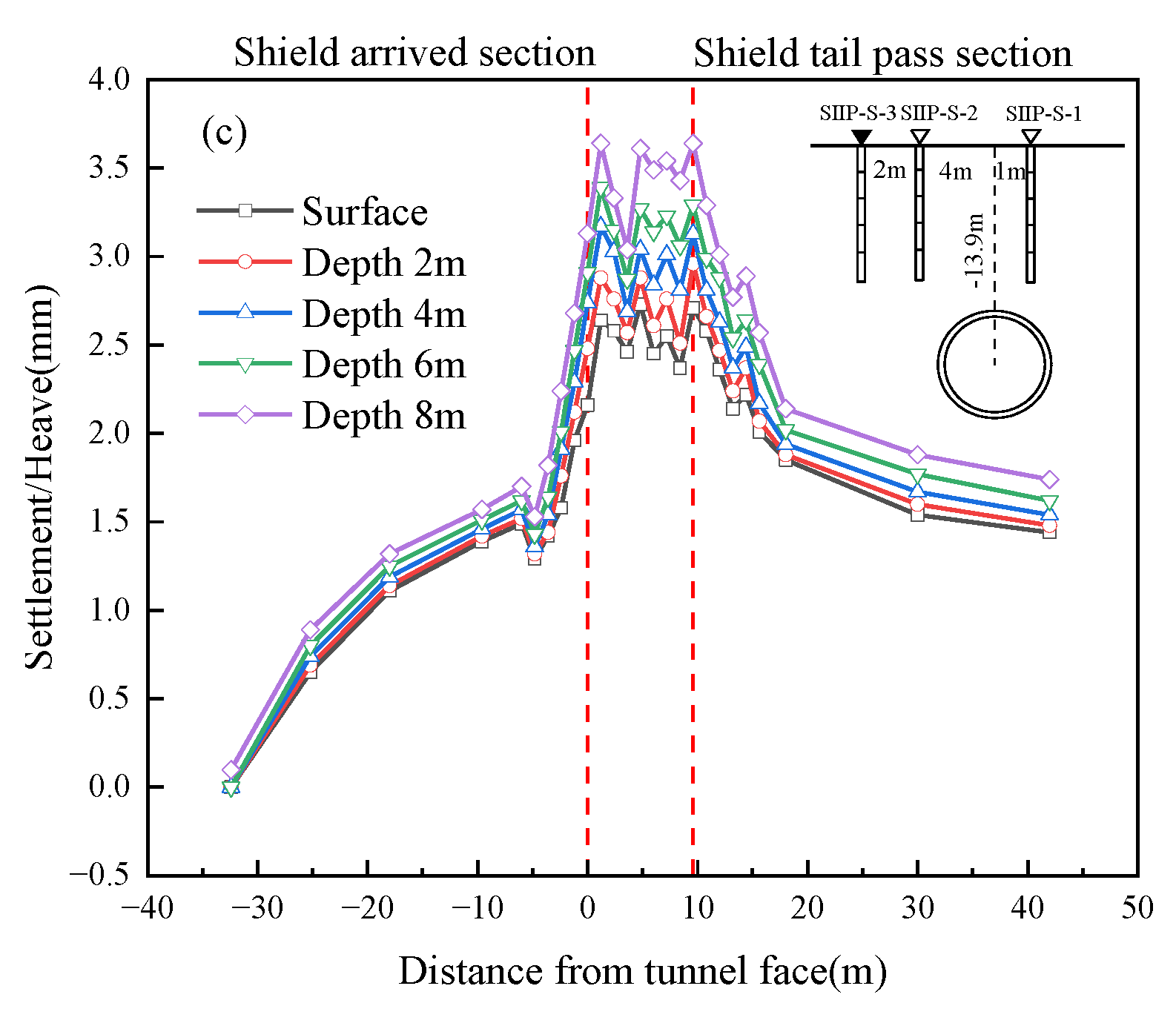
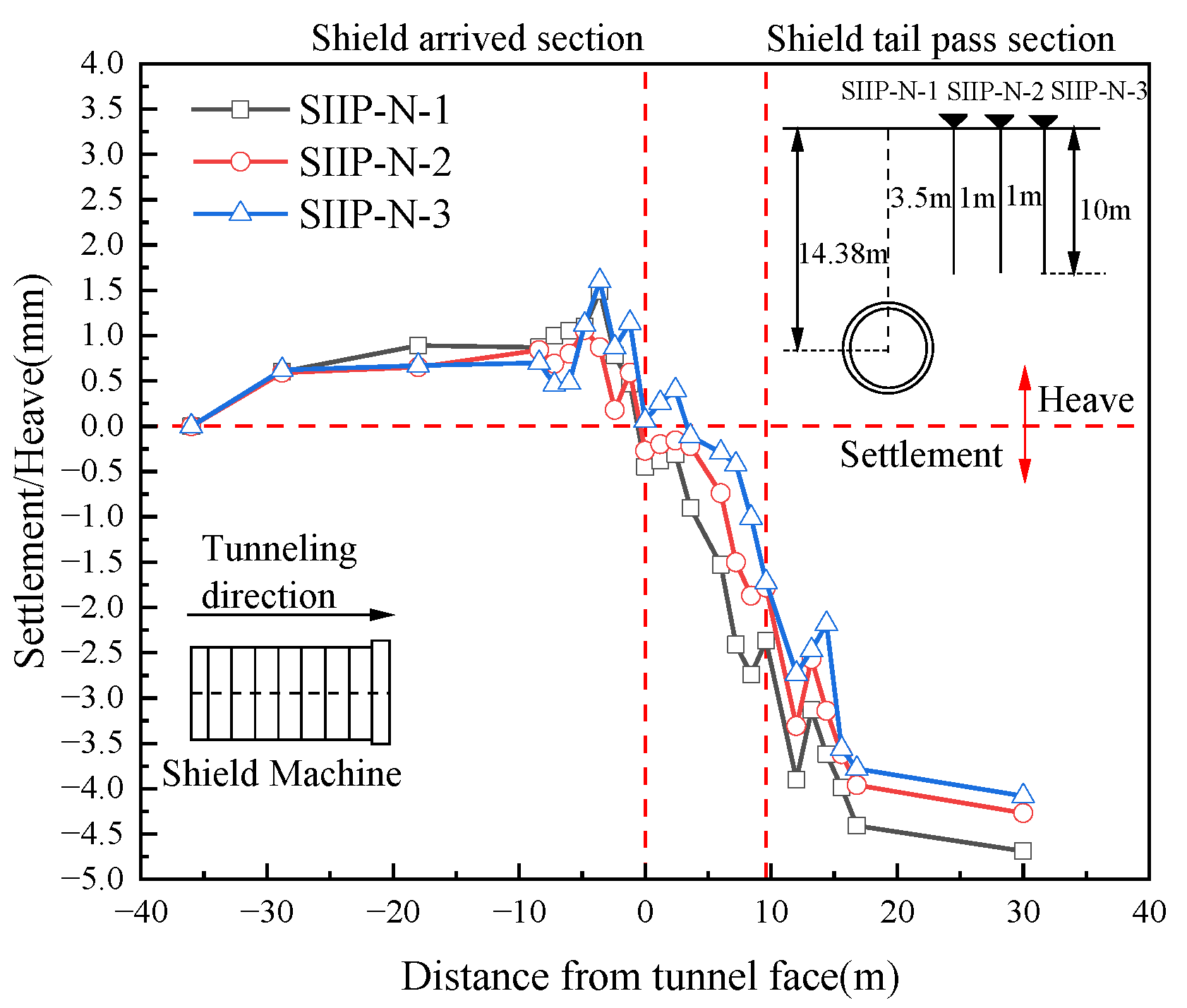

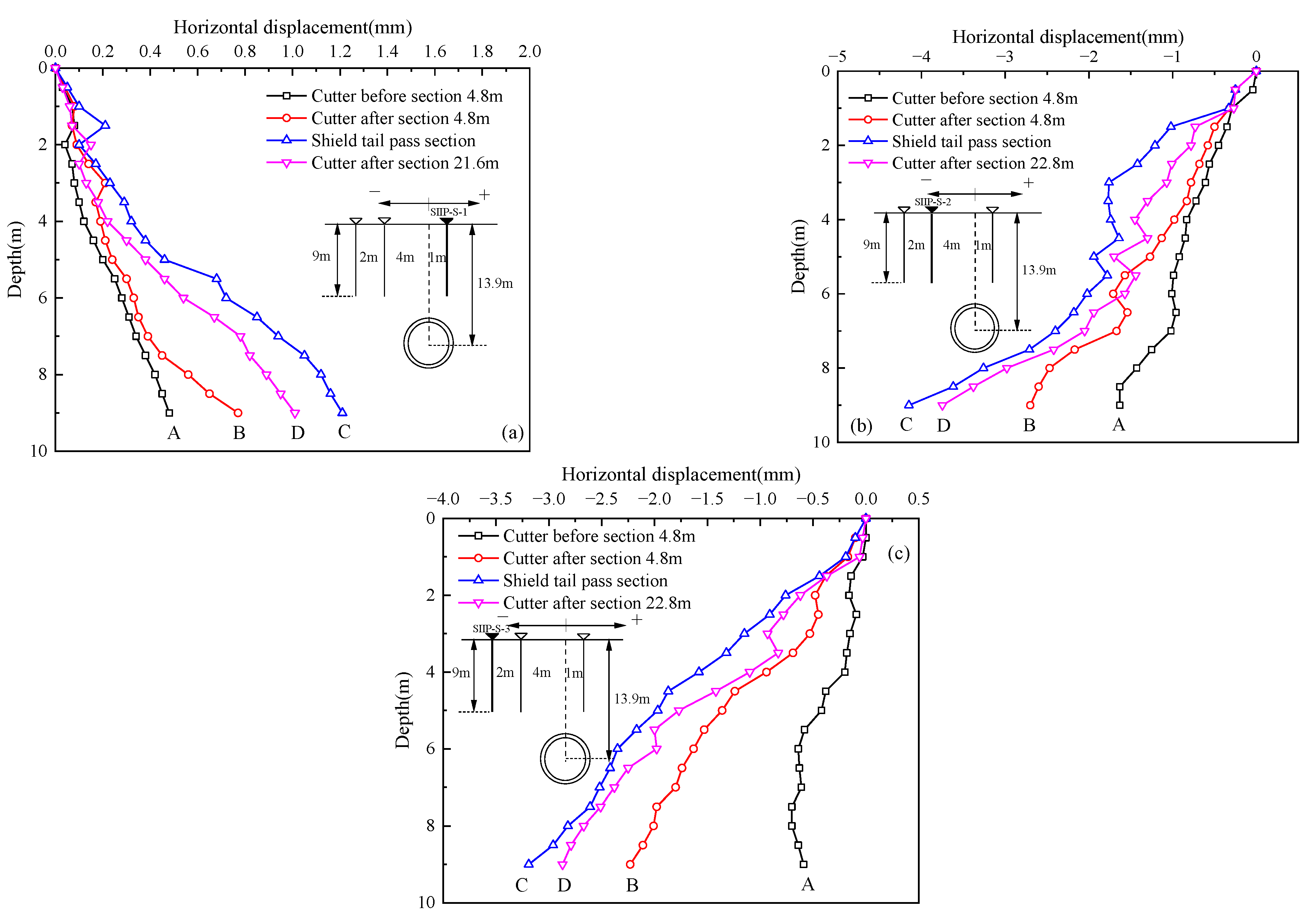



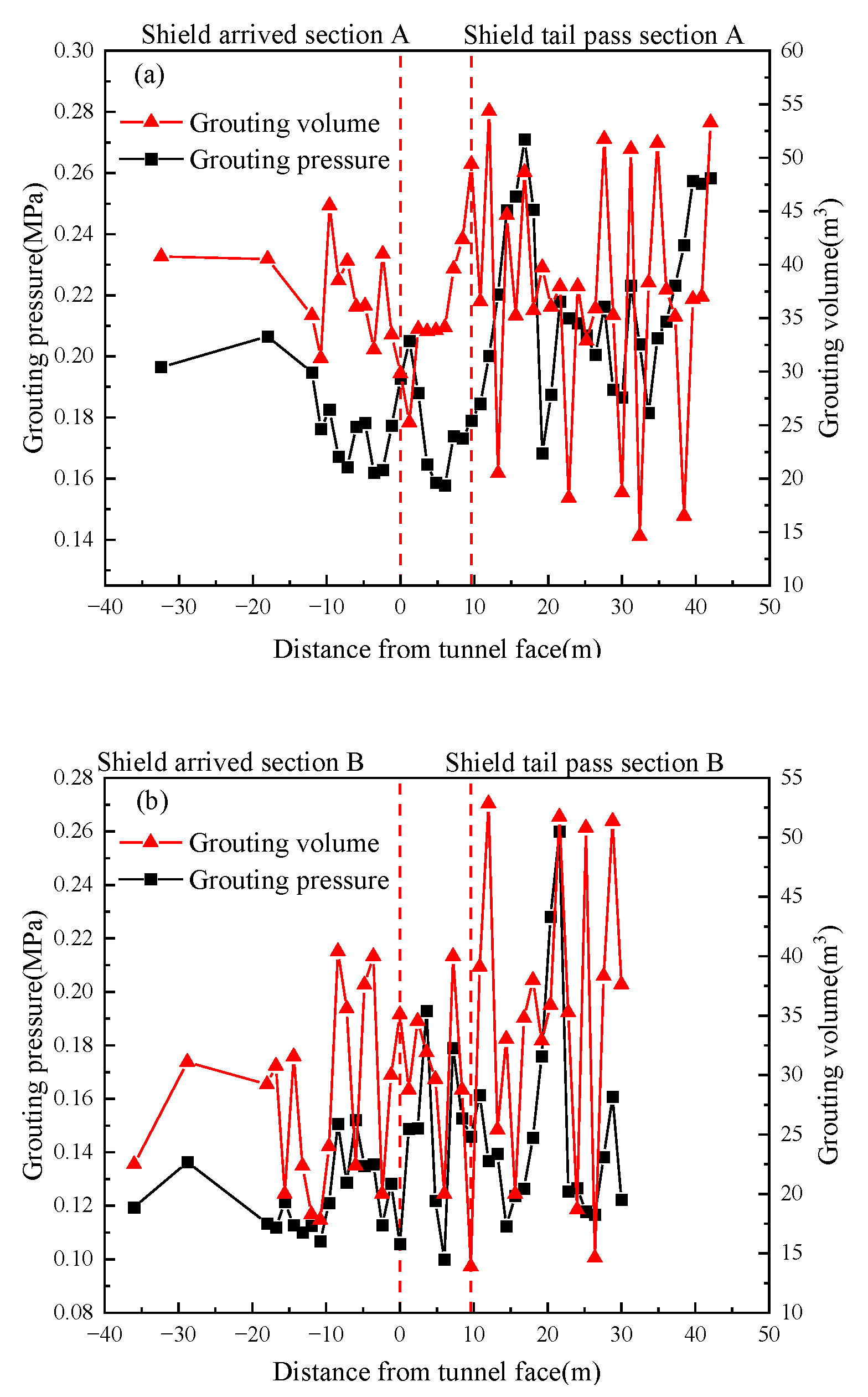


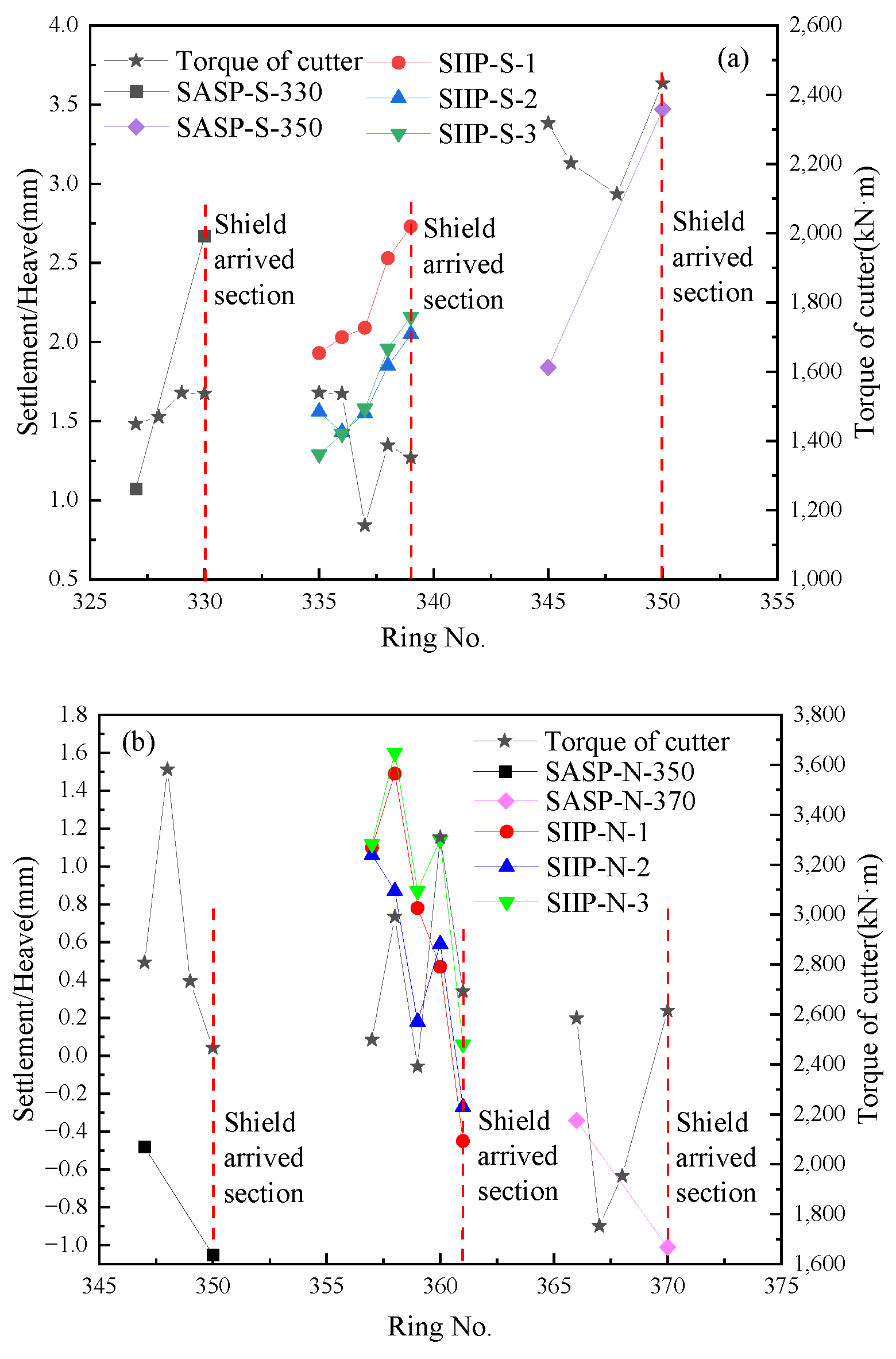
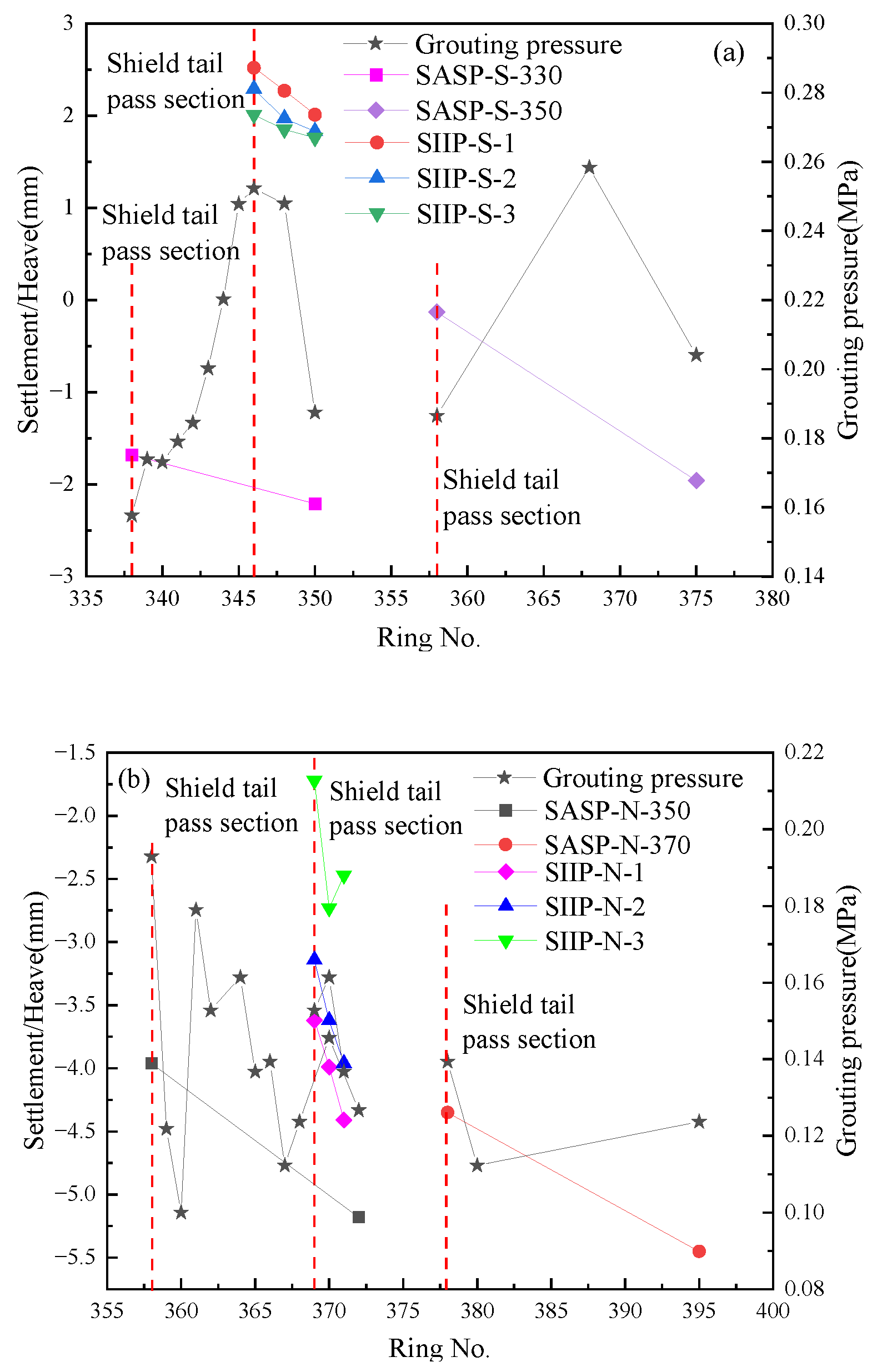
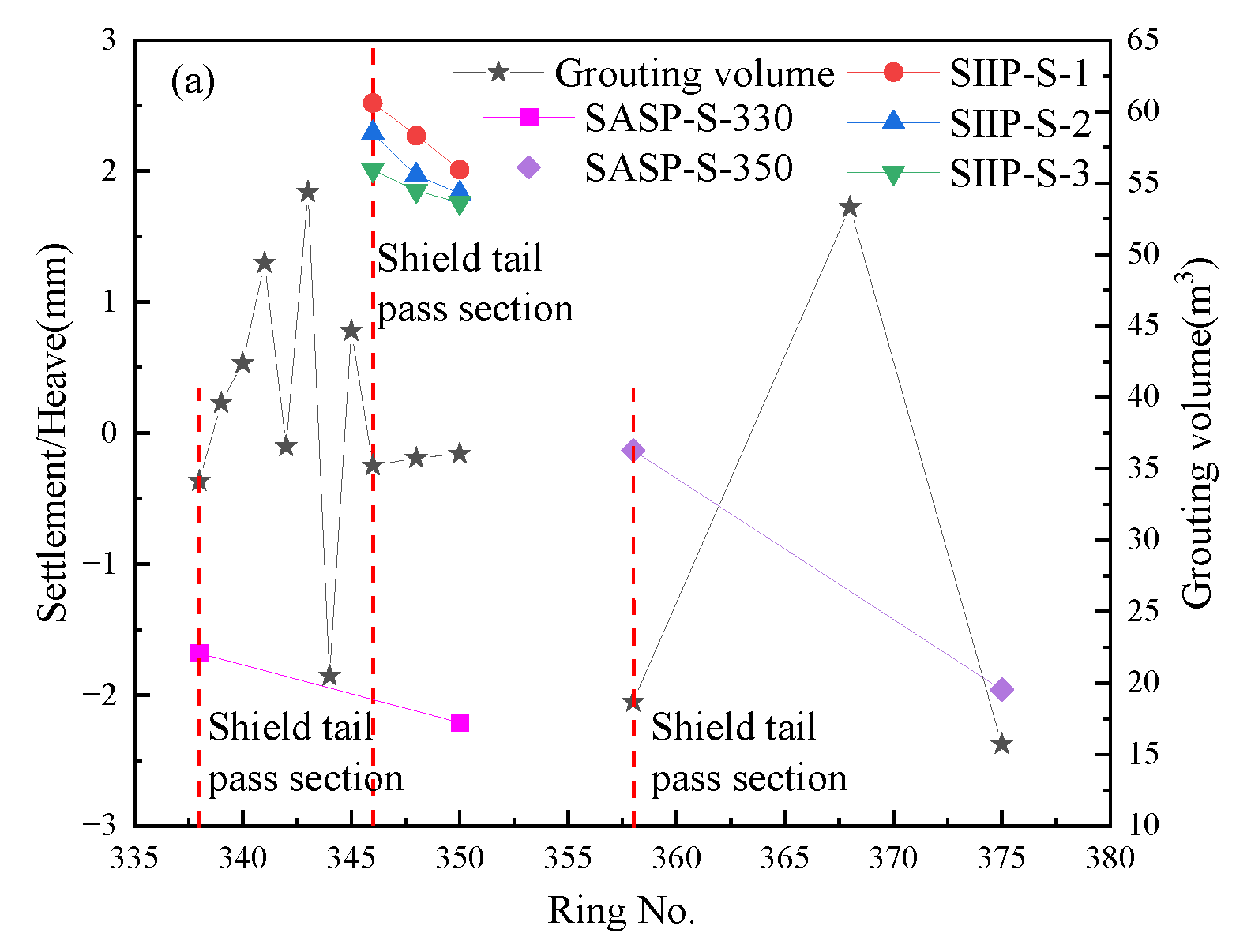

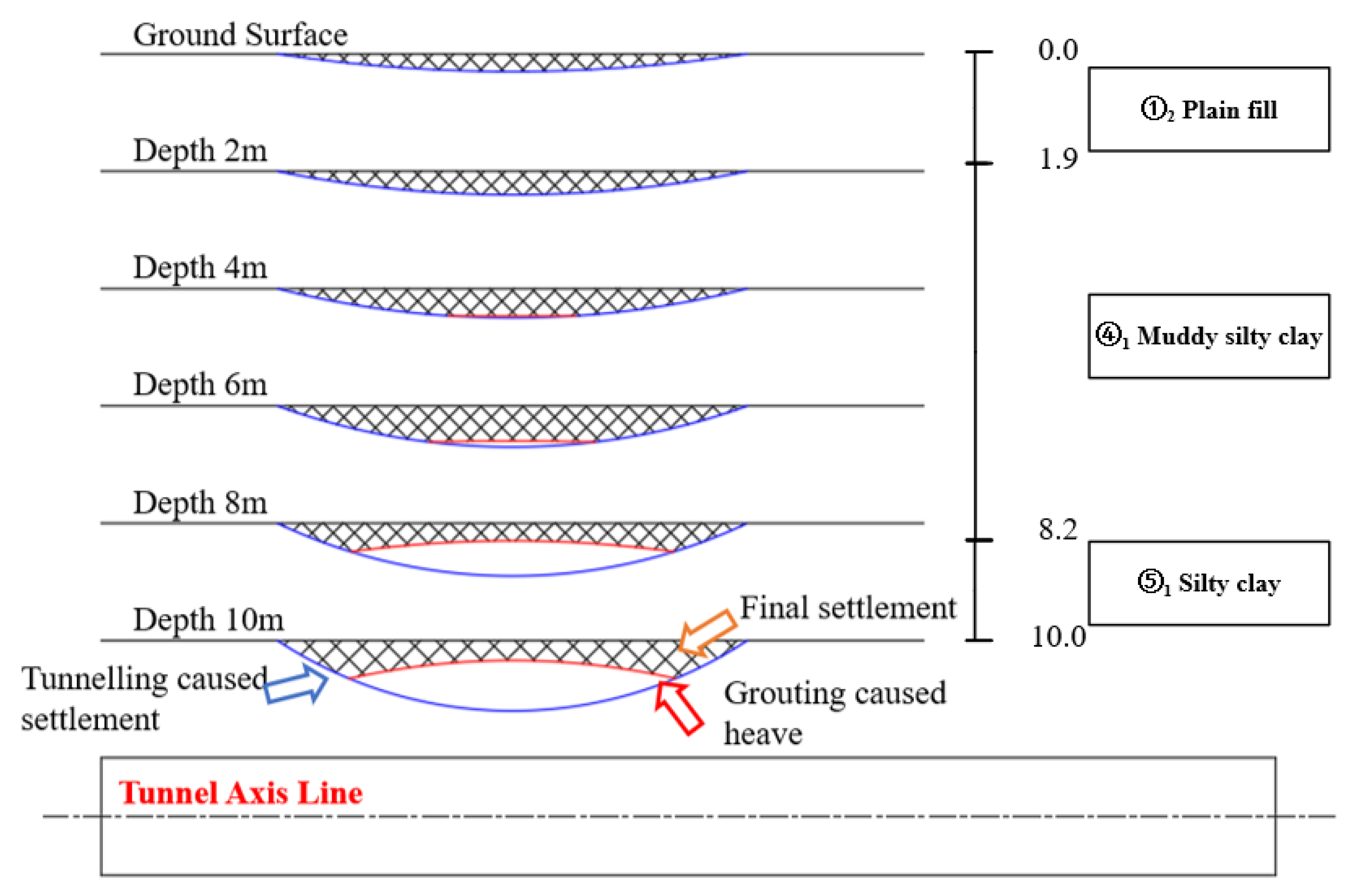
| Geotechnical Category | Water Content /(%) | Natural Unit Weight (kN/m3) | Specific Gravity of Soil Particle | Void Ratio | Liquid Limit (%) | Plastic Limit (%) | Poisson Ratio | Compression Modulus (MPa) | Cohesion (kN/m2) | Friction Angle (°) |
|---|---|---|---|---|---|---|---|---|---|---|
| ①2 Plain fill | 30.9 | 18.2 | 2.73 | 0.938 | 38.7 | 23.3 | 0.34 | 3.2 | 10 | 10 |
| ②2 Silty clay | 26.7 | 19.5 | 2.72 | 0.733 | 40.1 | 24.2 | 0.36 | 5.5 | 43 | 17 |
| ④1 Muddy silty clay | 45.4 | 17 | 2.73 | 1.287 | 38 | 23.1 | 0.4 | 2.3 | 13 | 9 |
| ⑤1 Silty clay | 26.1 | 19.5 | 2.73 | 0.733 | 40 | 24.1 | 0.36 | 5.5 | 43 | 17 |
| ⑨4 Round gravel | 22.5 | 20.5 | 2.7 | - | - | 0.26 | 17 | 2 | 34 | |
| (20)1 Fully weathered argillaceous siltstone | 21.9 | 19.6 | 19.6 | 0.674 | 40.1 | 24.1 | 0.28 | 6 | 25 | 27 |
| (20)2 Highly weathered argillaceous siltstone | 20.5 | 20.3 | 20.3 | - | - | - | 0.28 | 6 | 35 | 15.5 |
| (20)3 Medium weathered argillaceous siltstone | 22.4 | 24.5 | 24.5 | - | - | - | 0.28 | Incompressible | 170 | 33 |
| Monitoring Section | Stage of Shield Tunneling | ||||
|---|---|---|---|---|---|
| Cutter before Section | Cutter below Section | Crossing Section | Tail Pass Section | Final Settlement | |
| SSP-S-330 | 13% | 19% | 5% | 57% | 6% |
| SSP-S-350 | 18% | 16% | 6% | 42% | 18% |
| Monitoring Section | Stage of Shield Tunneling | ||||
|---|---|---|---|---|---|
| Cutter before Section | Cutter below Section | Crossing Section | Tail Pass Section | Final Settlement | |
| SSP-N-350 | 9% | 11% | 12% | 44% | 24% |
| SSP-N-370 | 6% | 12% | 16% | 46% | 20% |
Publisher’s Note: MDPI stays neutral with regard to jurisdictional claims in published maps and institutional affiliations. |
© 2022 by the authors. Licensee MDPI, Basel, Switzerland. This article is an open access article distributed under the terms and conditions of the Creative Commons Attribution (CC BY) license (https://creativecommons.org/licenses/by/4.0/).
Share and Cite
Wang, Z.; Feng, W.; Wu, S.; Wu, P.; Xu, S.; Yao, Z.; Sun, J. Research on Strata Deformation Induced by EPB Tunneling in Round Gravel Stratum and Its Control Technology. Appl. Sci. 2022, 12, 10553. https://doi.org/10.3390/app122010553
Wang Z, Feng W, Wu S, Wu P, Xu S, Yao Z, Sun J. Research on Strata Deformation Induced by EPB Tunneling in Round Gravel Stratum and Its Control Technology. Applied Sciences. 2022; 12(20):10553. https://doi.org/10.3390/app122010553
Chicago/Turabian StyleWang, Zhe, Weihao Feng, Shuwei Wu, Pengfei Wu, Sifa Xu, Zewei Yao, and Jiuchun Sun. 2022. "Research on Strata Deformation Induced by EPB Tunneling in Round Gravel Stratum and Its Control Technology" Applied Sciences 12, no. 20: 10553. https://doi.org/10.3390/app122010553




